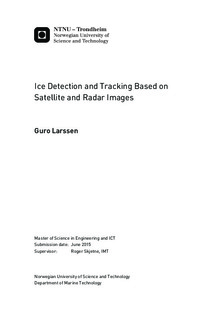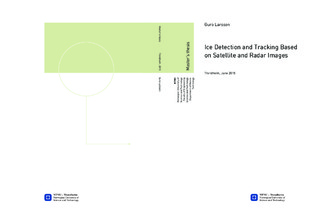| dc.description.abstract | The tracking and management of ice is a topic of great importance,
due to the dangers these ice targets pose to vessels and marine structures.
As the marine activity increase in ice affected areas, the motivation for developing
good methods for detection and tracking of ice is increased accordingly.
An important tool for this purpose is satellites.
Satellites can produce imagery of a range of resolutions, covering large areas.
An algorithm, implemented in MATLAB, for automatic tracking of targets in satellite images is proposed.
The algorithm have three stages: detection of targets, matching targets in the image
with targets from previous images, and classification of targets.
The matching is carried out using a geometrical shape representation rendered for each target,
and the classification feature uses a set speed limit to distinguish between vessel and ice targets.
The algorithm's performance was assessed by applying it to a set of
RADARSAT-2 images covering the Greenland East Coast.
The results proved the detection to be effective for targets not completely enclosed by ice.
However, tracking is not possible for very small targets only spanning a few pixels.
This proved to be an issue when trying to identify targets as vessels
with the classification feature.
To further investigate target discrimination in satellite images,
an analysis of the brightness return from different targets in multi-polarized imagery was carried out.
Vessel and ice targets were observed to have considerably different polarization responses.
By using a multi-polarized area ratio, it was showed that this could be used for
discrimination between vessel and ice targets.
A further indication of target types was found by comparing motion patterns of
free-floating ice targets with human-controlled vessels.
To be able to forecast the motion of ice, a dynamic model for iceberg drift is presented.
By using a Kalman filter, the velocity of the iceberg can be estimated.
The Kalman filter uses measurements from weather data and the position of the iceberg.
The position measurements needed in the filter can be found from using
the tracking algorithm on the satellite images.
However, in this thesis, the model was only simulated on synthetic data,
and not by using satellite images. | |

